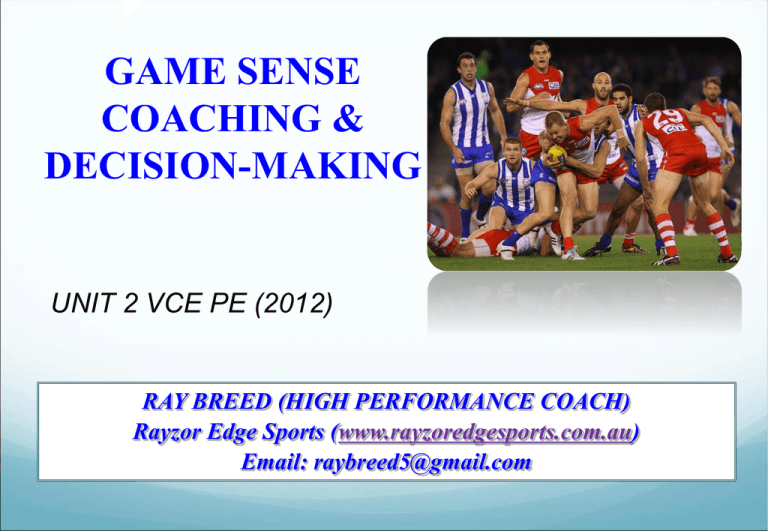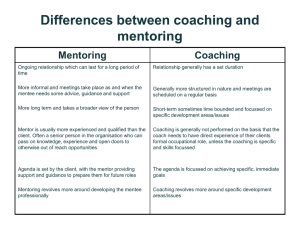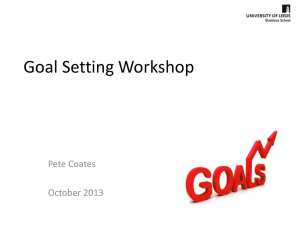the ppt
advertisement

GAME SENSE COACHING & DECISION-MAKING UNIT 2 VCE PE (2012) RAY BREED (HIGH PERFORMANCE COACH) Rayzor Edge Sports (www.rayzoredgesports.com.au) Email: raybreed5@gmail.com GAME SENSE COACHING & DECISION-MAKING UNIT 2 VCE PE (2012) Exerpts from the book: Breed & Spittle (2011): “Developing Game Sense through Tactical Learning – a resource for teachers and coaches”. Cambridge University Press (copy link below in to browser) http://www.cambridge.edu.au/education/teacher/title.php?s=secondary&n=Title&a=viewTitle&bid=300893#.UJoCL80UKKY RAY BREED (HIGH PERFORMANCE COACH) Rayzor Edge Sports (www.rayzoredgesports.com.au) Email: raybreed5@gmail.com GREAT PLAYERS GREAT COACHES TEAM SPORTS (1) Can you name the coaches and players above? (2) What do all of their sports have in common? (think ‘tactics’) GAME SENSE TGFU (UK) or “Tactical” approach Teaching/coaching that uses games to develop tactical/strategic thinking Modification for exaggeration Technique + Pressure = Skill Caption: Teaching Games for Understanding (TGfU): The Curriculum Model (Bunker & Thorpe, 1982) (From: Bunker, D., &Thorpe, R. (1986). Is there a need to reflect on our games teaching? In R. Thorpe, D. Bunker, & L.Almond (Eds.), Rethinking games teaching (pp. 30). Loughborough, UK: Loughborough University of Technology.) 4 What is ‘skill’? Skill = Technical skill + Tactical skill + Pressure Features of Game Sense drills: 1.‘Open’ skill drills (repetition of a skill in variable situations) 2.Implicit learning 3.Questioning 4.Repetition of tactical scenarios 5.Variable conditions “Great players are NOT born – they are developed through practice and hard work!” (Jordan) 5 DM involves: TACTICAL KNOWLEDGE: What to do if…..? (game understanding/rules/team plans/probabilities) READING PLAY: Pattern recognition/movement cues The DM process: 1. SCANNING 2. PERCEPTION 3. ATTENTION INSTRUCTION VS “INATTENTIONAL BLINDNESS” 4. RESPONSE SELECTION 5. SKILL EXECUTION 6 Training involves 3 main areas of improvement: (1) Technical skill (2) Tactical skill** (3) Style of play •Eg. Kick to adv, cont marking, set shots •High reps/low pressure •Explicit & implicit •Indiv/small-sided drill •Improve DM •Skill eff under pressure •EG: ‘Game Sense’! •High reps/pressure •Implicit/variable •Small-sided games •Framework within decisions are made •Team plays/structures •EG: ‘Game Plan’! •Low reps/pressure •Large-sided games •Explicit & implicit •Structured scenarios IMPLICIT: learning through experience without direct instruction EXPLICIT: learning through direct instruction Why implicit game-based training? Elite players have better DM skills “Open” skilled game i.e., techniques executed in variety of situations Well-rehearsed techniques can break down under fatigue & pressure Research strongly supports implicit training is more effective in transferring to performance than explicit (structured drills) methods Implicit games are more durable in terms of player learning Features of implicit game-based training: Player-centred – coaches guide/facilitate players to explore options Coach asks questions Emphasis on DM in tactical situations that can occur in a match Implicit learning – learn sub-consciously/‘learning from mistakes’ Indirect learning through problem solving The Coach is a FACILITATOR 8 How does Game Sense work? 1. Techniques (movement patterns) can break down in competitive situations with ‘distractions’ 2. Practicing with variety of scenarios can improve attention to only ‘relevant’ cues 3. Improve DM skills through ‘experience’ i.e., learning from good and poor decisions 4. Repetition – small-sided games 5. DM becomes automatic (sub-conscious) 6. ‘Need to make mistakes to learn!’ “A poor performance is not failure, it is feedback!” 9 10 COACHING GAME SENSE GUIDELINES FOR DEVELOPING GAMES/TRAINING 1. Aim or theme (expected outcomes?) 2. Small-sided (2-6) 3. Replicate typical scenarios 4. Length – time for repetition 5. Main rules & area 6. Variations of game 7. Prepare questions 8. Block or Random/variable practice? COACHING GAME SENSE GUIDELINES FOR TEACHING THE GAME 1. (Explain purpose) 2. Brief explanation of rules/limitations 3. Let game ‘play’ & observe (evaluate) 4. Is it working? Modifications? 5. Vary pressure/difficulty 6. Ask individual questions during game 7. Teachable Moments 8. Freeze play – ‘walk through’ demo 9. Feedback on decisions 10.Turn FB into questions 12 COACHING GAME SENSE QUESTIONING Coach’s role to assist players in solving tactical problems 4 concepts: 1. TIME – when should you…….? 2. SPACE – where should you…….? 3. RISK – which option…….? 4. EXECUTION – how should you……? Use open-ended questions Turn feedback into questions: when, what, where, why, how? 13 COACHING GAME SENSE CONSTRAINTS-LED APPROACH 1. Level of pressure/tackling 2. Size/shape of area 3. No of players (def/att)/size of teams 4. Rules 5. Time in possession 6. Method of scoring/points eg. 3 pt 7. Positions/zones 14 COACHING GAME SENSE PRESENTING GAMES: To develop strategy we can: 1. Stay in A or D role for time of no. of turns 2. Give one gp a task 3. Set scenarios 4. Observation 5. Experienced v inexperienced 15 COACHING GAME SENSE EVALUATING THE GAME 1. Did game address aims? 2. Could game be modified? 3. Sufficient repetition of skills? 4. Player involvement maximised? 5. Game progressions? 16 PART 2: GAME SENSE IN ACTION SMALL GROUP PEER COACHING (1) 3 Teams of 6-8 (2) You will have 3 roles throughout the session: (1) Player within a team (2) Observation of opposition team tactics (3) Observation of coaching strategies/styles (3) Play 3-4 games: (1) 2 teams play (2) 1 team observes opposition and coaching methods eg. questioning, feedback, changing game constraints 17 PART 2: GAME SENSE IN ACTION SMALL GROUP PEER COACHING Teacher to select from the following games (play each game for 20-30 minutes) using a variety of balls/rules. (1)Warm-up game – 2v1 tag (variation 4v2 tag) (2)2v1 Gauntlet (variation 3v2 gauntlet) (3)Team tag (4)Prison Break NB: see Breed & Spittle (2011) book for game descriptions 18 19 20






